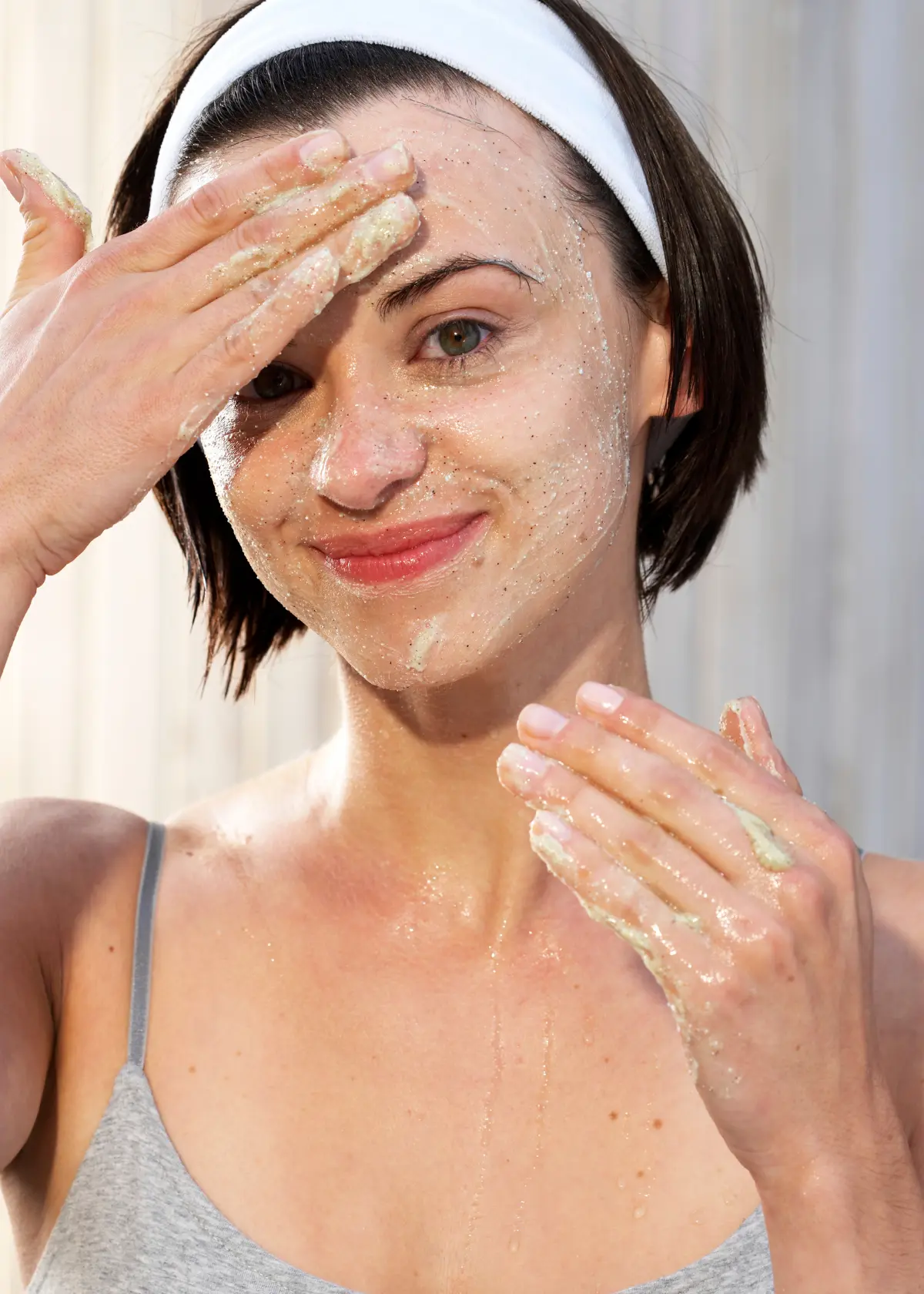Are you frustrated with the stubborn dark spots marring your complexion? Hyperpigmentation, a common skin issue caused by excess melanin, can be difficult to tackle.
But does exfoliating help with hyperpigmentation? Yes, it does to some extent.
In this article, we will guide you through how exfoliation plays a role in managing and even reducing these pigmented patches.
So continue reading as we peel away the layers of this skin concern.
How Exfoliation Helps to Treat Hyperpigmentation?

Exfoliation plays a crucial role in managing hyperpigmentation as it helps break up pigmented cells and sheds dead skin cells.
Exfoliating can help break up pigmented cells, which are responsible for dark spots and uneven skin tone caused by hyperpigmentation. By removing the top layer of dead skin cells through exfoliation, you can encourage the turnover of new skin cells and reveal fresher, brighter skin underneath.
This process helps to fade existing pigmentation and prevent the formation of new dark spots.
Whether you choose physical exfoliation methods like microdermabrasion or chemical exfoliation with products containing AHA, BHA, or vitamin C, incorporating regular exfoliation into your skincare routine is an effective way to tackle hyperpigmentation and achieve a more even complexion.
Exfoliating is an effective way to address hyperpigmentation because it helps in shedding dead skin cells. When you exfoliate, the outer layer of your skin is gently buffed away, revealing fresher and brighter skin beneath.
By removing this layer of dead skin cells, exfoliation can aid in reducing the appearance of dark spots and uneven skin tone caused by hyperpigmentation.
It also allows for better absorption of skincare products, making them more effective in targeting pigmented areas.
So, incorporating regular exfoliation into your skincare routine can help promote a smoother and more even complexion.
Different Methods of Exfoliation for Hyperpigmentation
There are two main methods of exfoliation for hyperpigmentation: physical exfoliation and chemical exfoliation.
Physical Exfoliation (Microdermabrasion, Scrubs)

Physical exfoliation methods like microdermabrasion and scrubs are effective for treating hyperpigmentation.
Microdermabrasion uses tiny crystals to gently remove the top layer of skin, helping to break up pigmented cells and reveal fresh, new skin beneath.
This can help improve the appearance of dark spots and create a more even skin tone. Scrubs, on the other hand, physically slough off dead skin cells when massaged onto the skin.
By shedding these cells, scrubs can also contribute to reducing hyperpigmentation and revealing brighter, smoother skin. Another way is by using hyperpigmentation body wash with the scrubs.
Regular use of physical exfoliation methods can be helpful in fading dark spots over time and improving overall complexion.
Chemical Exfoliation (Products with AHA, BHA, and Vitamin C)

Chemical exfoliation using products with ingredients like AHA, BHA, and vitamin C can be highly effective for treating hyperpigmentation. These products work by penetrating deep into the skin to break down pigmented cells and promote the shedding of dead skin cells.
You can also find chemical peels for proper exfoliation. This helps to fade dark spots and improve overall skin tone. Unlike physical exfoliation methods, chemical exfoliation works at a deeper level and can provide more noticeable results.
Incorporating these products into your skincare routine can help accelerate the fading process of hyperpigmentation and give you a brighter, more even complexion over time.
Benefits and Considerations of Exfoliating for Hyperpigmentation
Exfoliating for hyperpigmentation offers multiple benefits, including accelerating the fading process of dark spots and promoting an even skin tone. However, it is crucial to exercise caution and be aware of potential risks associated with exfoliation.
Accelerating Fading Process
Exfoliating is an effective way to speed up the fading process of hyperpigmentation. By removing the top layer of skin, exfoliation helps to shed dead cells that contain excess melanin, which contributes to dark spots and uneven skin tone.
Chemical exfoliation, such as using products with alpha-hydroxy acids (AHA) or beta-hydroxy acids (BHA), can penetrate deeper into the skin and provide more efficient results. Regular exfoliation combined with a skin-lightening agent like vitamin C can further enhance the fading process by breaking down pigmented cells and promoting a brighter complexion.
Remember to be consistent in your exfoliation routine to see noticeable improvements in reducing hyperpigmentation.
Removes Surface Pigmentation

Exfoliating the skin through mechanical or chemical means sloughs off the top layer of pigmented skin cells. This abrasive removal takes away the buildup of excess melanin on the surface of the skin that is causing the dark patches and discoloration.
By gently wearing away the outer pigmented layer, exfoliation is able to gradually reduce the intensity and appearance of hyperpigmentation over time. With consistent and routine exfoliation, the pigmented cells on the surface continue to be removed and replaced with new skin cells.
This continual exfoliation process is able to meaningfully improve the appearance of discoloration when done regularly over an extended period.
Evens Skin Texture
In addition to the buildup of excess melanin, hyperpigmentation can also be exacerbated by the accumulation of dead skin cells and debris on the surface of the skin.
This creates an uneven, rough texture that makes the hyperpigmentation patches appear more visible and pronounced. Exfoliation is beneficial because it works to smooth and even out the texture of the skin through its abrasive scrubbing motion.
By sloughing off the dead cells and debris, exfoliation reveals the newer and smoother skin underneath. This helps to reduce the exaggerated appearance of the pigmentation by creating a more uniform texture and tone across the face or affected area.
An improved and more balanced texture helps make areas of discoloration far less noticeable.
Allows Treatment Penetration
When medicated creams, serums, or other topical treatments are used in conjunction to treat hyperpigmentation, exfoliation can significantly improve their effectiveness.
The removal of the dull outer layer of dead skin cells allows the active ingredients in these pigmentation treatments to better absorb into the skin and penetrate to where they are needed.
With a clean and smooth canvas, ingredients such as hydroquinone, glycolic acid, salicylic acid, kojic acid, or vitamin C are able to go deeper to reach the melanocytes and target the cells that are overproducing melanin.
By enabling better delivery of the treatment ingredients, exfoliation helps maximize their ability to inhibit further melanin production and reduce existing discoloration.
Speeds Cell Turnover
In addition to removing pigmented surface cells, exfoliation has the added benefit of prompting faster cell renewal. The exfoliation process signals to the basal layer of the epidermis to generate newer skin cells at a quicker rate. This speeds up the natural turnover cycle, causing skin cells to be shed and replaced more rapidly.
By accelerating cell turnover, exfoliation helps replace the older pigmented cells on the outer surface with newer and healthier cells.
The constant formation of new cells minimizes the accumulation of excessive melanin. This quicker cell regeneration rate in turn reduces the prevalence of stubborn hyperpigmentation. It also helps with treating post-inflammatory hyperpigmentation (PIH).
Prevents Future Discoloration
Consistent and thorough exfoliation not only improves existing pigmentation but can also help prevent future discoloration from forming. By constantly wearing away and sloughing off dead, damaged skin cells through exfoliation, you continually remove potential sites where excess melanin could become trapped.
It evenly resurfaces the skin, minimizing the opportunity for uneven pigment clumping. Regular exfoliation can also fade early onset sun spots and damage caused by UV rays before they have a chance to become more pronounced.
Keeping the skin's cell turnover high and its surface clear of debris provides protection against further unwanted melanin deposits.
Potential Risks and Precautions

Exfoliating can be beneficial for treating hyperpigmentation, but it is important to take some precautions to avoid potential risks.
Over-Exfoliation
While regular exfoliation can improve hyperpigmentation, overdoing it can seriously damage the skin. Exfoliating too harshly or too frequently can cause irritation, inflammation, dryness, peeling, redness and even bleeding. It disrupts the natural skin barrier and moisture levels.
Signs of over-exfoliation include sensitivity, stinging, tightness, and flakiness. Those with hyperpigmentation should exfoliate cautiously 1-2 times per week and adjust based on the skin's tolerance.
Aggravating Sensitive Skin
Those with sensitive skin conditions like eczema, rosacea, and psoriasis need to be extra careful with exfoliation.
The friction and chemicals can trigger flares, irritation, and inflammation that actually worsen discoloration. Sensitive skin may not be able to tolerate daily exfoliation. Work up gradually from 1-2 times a week and discontinue use if skin becomes irritated.
UV Exposure
One major precaution is avoiding sun exposure after exfoliating. The removal of the top skin layer leaves fresh new skin exposed. This highly sensitive skin is vulnerable to UV damage if not protected.
The post-exfoliation inflammation from sunburns can greatly exacerbate hyperpigmentation. Always apply SPF 30+ sunscreen after exfoliating. Limit direct sun contact until the skin adjusts.
Proper Technique
Using proper technique is key, especially with physical exfoliants. Scrubbing too harshly or using gritty, abrasive scrubs can cause microtears.
This inflames the skin and induces more melanin production. Gently massage in circular motions using finely ground scrubs. Start with gentler chemical exfoliants if the skin is very sensitive.
Adjusting Other Products
After introducing exfoliation, you may need to adjust the use of other products like retinoids and benzoyl peroxide which can dry out the skin.
Use hydrating serums and occlusive moisturizers to counteract the drying effects of combined exfoliating products. Reducing the frequency of exfoliation may also be required.
Consulting a Dermatologist
Those with moderate to severe hyperpigmentation should consult a dermatologist before attempting to exfoliate at home.
A dermatologist can assess your individual pigmentation severity, skin type, and sensitivities. They can provide personalized guidance on safe exfoliation techniques, treatment options, and proper post-procedure skin care.
Patch Testing
If using a new chemical exfoliant, always do a patch test first. Apply a small amount on your inner arm for a few days to check for any adverse reactions before using it on your face or larger surface areas.
Look for irritation, redness, swelling, or increased pigmentation which are signs of sensitivities.
Avoiding Permanent Damage
While exfoliation gently removes the uppermost layer of pigmented skin, attempting to aggressively scrub away dark spots can permanently damage skin and cause scarring.
Hyperpigmentation should be treated under the guidance of a dermatologist using the best medical practices and procedures for your specific case. Always consult the experts.
Realistic Expectations
While exfoliation improves hyperpigmentation, it works gradually over time and does not make discoloration vanish overnight. Be patient and maintain a consistent exfoliation routine. Avoid "quick fix" treatments that inflame skin since they can worsen and spread pigmentation on darker skin tones.
Temper expectations for full elimination of spots. Some hyperpigmentation may persist depending on underlying causes and your skin type.
Cautious Approach
When in doubt, take the most gentle and cautious approach possible. Start very conservatively and slowly increase exfoliation frequency and intensity based on the skin's response. There is no need to rush the process or use harsh products.
Consistency is key for long-term improvement. Listen to your skin and adjust techniques accordingly. Consult dermatology experts for individualized guidance on appropriate exfoliation methods.
Frequently Asked Questions
We've dug into the research to bring you the lowdown on how exfoliants like AHAs and BHAs can improve hyperpigmentation.
The forthcoming FAQs will clue you in on the best exfoliants to try, how often to use them, what to avoid, and more tips to effectively and safely exfoliate away hyperpigmentation.
Can exfoliating help with hyperpigmentation?
Exfoliating can help improve the appearance of hyperpigmentation by removing dead skin cells and promoting cell turnover, but it may not completely eliminate it.
How often should I exfoliate to see results for hyperpigmentation?
To see results for hyperpigmentation, it is recommended to exfoliate 2-3 times per week using a gentle exfoliant suitable for your skin type.
Are there any risks or side effects of exfoliating for hyperpigmentation?
Excessive or harsh exfoliation can irritate the darkened skin cells and worsen hyperpigmentation. It's important to use gentle exfoliants and avoid scrubbing too hard to prevent damage.
Should I consult a dermatologist before incorporating exfoliation into my skincare routine for hyperpigmentation?
If you have severe or persistent hyperpigmentation, it is advisable to consult a dermatologist before starting an exfoliation regimen. They can provide personalized advice based on your specific skin condition.
Conclusion
Exfoliating is an important step in managing hyperpigmentation. By breaking up pigmented cells and shedding dead skin cells, exfoliation can help lighten dark spots and even out skin tone.
Whether through physical exfoliation or chemical exfoliation with products containing AHA, BHA, or vitamin C, incorporating proper exfoliation into your skincare routine can accelerate the fading process of hyperpigmentation and improve the overall appearance of your skin.
So, don't forget to exfoliate regularly for a brighter complexion. To dissolve dead skin cells, chemical exfoliants are a great choice.



